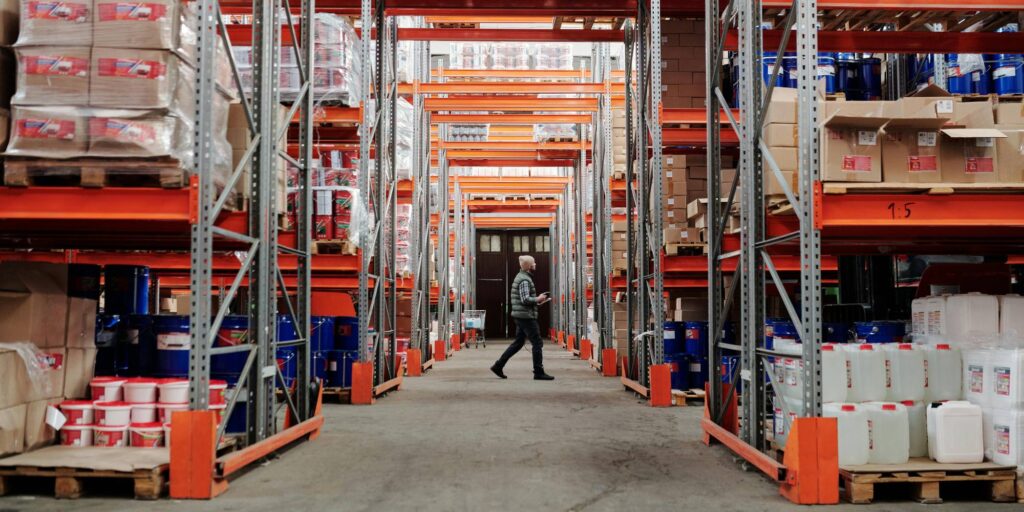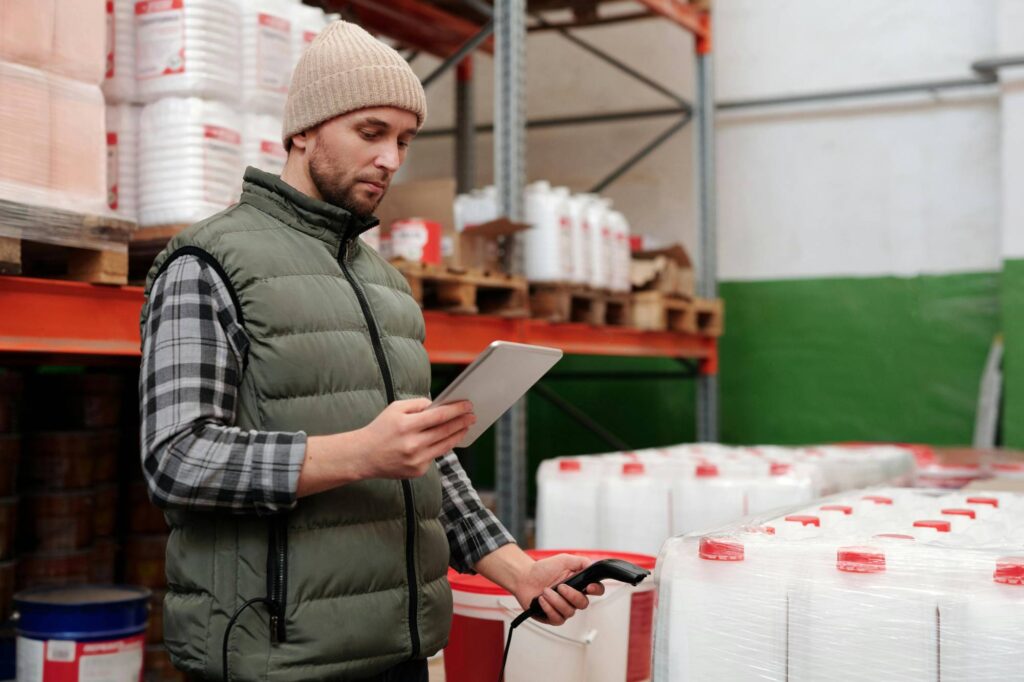In logistics, real-time responsiveness is a necessity. As customer expectations evolve and supply chains become increasingly complex, logistics providers must rely on advanced systems that ensure accuracy, speed, and efficiency. A 3PL warehouse management system is central to achieving these goals, especially when it delivers real-time capabilities.
Here are reasons why logistics businesses need a real-time third-party logistics warehouse system.
Table of Contents
Key Takeaways
✔ Real-time systems provide end-to-end visibility across inventory, shipments, and warehouse sites, allowing for faster and more informed decision-making.
✔ Automation and live updates built into a 3PL warehouse management system significantly reduce manual errors and improve data accuracy.
✔ Dynamic labor allocation, automated workflows, and performance monitoring enhance overall warehouse efficiency and throughput.
✔ Real-time inventory tracking and client-accessible dashboards increase customer satisfaction through transparency and trust.
✔ Immediate alerts and intelligent workflows enable proactive problem resolution before issues escalate into delays or disruptions.
✔ Leveraging advanced reporting and analytics helps logistics providers gain a competitive edge in the 3PL market.
✔ A scalable, real-time warehouse system supports business growth by accommodating new clients, products, and facilities seamlessly.
What Is a Real-Time 3PL Warehouse Management System?
A 3PL warehouse management system (WMS) is a specialized platform designed to help third-party logistics providers track, manage, and optimize warehouse operations. Real-time WMS solutions go a step further by continuously updating and syncing data across the supply chain. As of 2024, 93% of warehouses have implemented WMS software, reflecting a significant shift towards digitalization in warehouse operations.
Unlike traditional systems that operate in batch or delayed modes, a real-time third-party logistics warehouse system provides instant access to critical metrics. These include inventory status, order processing stages, shipment tracking, and more, all without delays.
Modern WMS platforms use a combination of cloud computing, APIs, mobile devices, and Internet of Things (IoT) sensors to capture data as it happens. This ensures that everyone, from warehouse workers to logistics managers and clients, has an up-to-the-minute view of operations.
7 Key Advantages of Real-Time 3PL Warehouse Management Systems
1. Improve Visibility Across the Supply Chain
One of the most transformative advantages of a real-time third-party logistics warehouse system is the ability to achieve total visibility throughout the supply chain. This transparency empowers logistics teams, clients, and partners to make fast, informed decisions at every stage of fulfillment.
Key Visibility Features
- Live SKU Tracking: Know the exact status and location of each item—whether it’s in storage, in picking, on the dock, or out for delivery—using real-time inventory tracking.
- Unified View Across All Sites: Real-time data feeds from each facility ensure multi-location inventory tracking is accurate, helping businesses manage distributed inventories without confusion or lag.
- Customer Portals and Dashboards: Interactive interfaces let clients and internal teams view inventory, order statuses, and shipment progress, removing the need for constant manual updates or email follow-ups.
- Transportation Channel Monitoring: Integrate WMS with your transportation management systems to track inbound and outbound shipments in real time, reducing missed or delayed deliveries.
- Performance Visualization: Use advanced reporting and analytics to generate heatmaps, trend graphs, and bottleneck indicators, giving managers the ability to predict and resolve issues before they impact operations.
- Role-Based Data Access: Provide access levels tailored to departments or clients, ensuring each user gets the relevant insights they need without compromising sensitive data.
2. Enhance Accuracy and Eliminate Manual Errors
In a logistics environment, precision is everything. Even a single mispick or mislabeled pallet can disrupt workflows and affect customer satisfaction. A real-time 3PL warehouse management system helps eliminate manual mistakes and fosters consistency across every process.
Accuracy-Driven Tools and Tactics
- Automated Data Collection: Replace manual entries with system-driven inputs that capture accurate product details, timestamps, and locations instantly.
- Barcode and QR Code Scanning: Scanning each item during receiving, put-away, picking, and shipping dramatically reduces errors in SKU handling and shipment processing.
- RFID Integration: Radio Frequency Identification allows passive scanning of products moving through checkpoints—ideal for bulk verification or high-speed environments.
- Mobile Inventory Management: Mobile-enabled devices ensure warehouse staff can perform actions like cycle counting, receiving, or transfers while updating the third-party logistics warehouse system in real time.
- Error Alerts and Exception Handling: System-generated alerts notify users of quantity mismatches, unexpected locations, or processing delays—empowering staff to correct issues before they snowball.
- Consistent Documentation: Auto-generated packing lists, shipping labels, and receipts ensure that documentation is uniform and aligns with client-specific requirements.
- Multi-Warehouse Synchronization: Real-time synchronization ensures multi-location inventory tracking remains consistent, even during high-volume periods or stock transfers.

3. Boost Warehouse Efficiency and Throughput
Real-time insights from a third-party logistics warehouse system are essential for unlocking higher warehouse productivity. With accurate, instant data, warehouse managers can respond to operational demands without delay. By combining all these features, a 3PL warehouse management system can significantly increase order accuracy, reduce lead times, and enhance fulfillment reliability.
Efficiency-Enhancing Capabilities
- Dynamic Labor Allocation: Assign tasks based on current order volume, inventory movement, and staffing levels. This helps reduce idle time and prevents overstaffing during slower periods.
- Task Prioritization and Routing: Use real-time data to prioritize urgent orders and optimize picking paths. This minimizes walking time and speeds up the fulfillment cycle.
- Workflow Automation: Automate repetitive tasks such as label printing, order verification, and replenishment alerts—freeing up staff for more value-added work.
- Live Performance Monitoring: Supervisors can track KPIs such as pick rate, pack rate, and error rate through advanced reporting and analytics, enabling on-the-spot coaching or adjustments.
- Bottleneck Detection: Identify congestion points in staging, picking, or shipping zones through heatmaps or throughput analysis. Adjust resources in real time to keep operations flowing smoothly.
- Proactive Inventory Management: Receive alerts for low stock levels, misplaced items, or SKU discrepancies. Combined with real-time inventory tracking, this ensures smoother restocking and fewer delays.
- Reduced Turnaround Times: Faster processing of incoming and outgoing shipments leads to better utilization of dock space and quicker cycle times.
4. Strengthen Customer Satisfaction and Trust
Real-time technologies offer clients the transparency they expect and the control they value. Ultimately, a third-party logistics warehouse system that prioritizes transparency, supported by real-time inventory tracking, empowers clients with confidence and leads to long-term retention.
Trust-Building Tools and Benefits
- Real-Time Order Tracking: Clients can track the status of their orders—from receipt to shipment—without needing to contact support. This is made possible by real-time inventory tracking synced across all channels.
- Client-Specific Portals: Personalized dashboards display order history, live stock levels, and shipment progress, improving client autonomy and satisfaction.
- Consistent Communication: System-triggered notifications provide automatic updates when orders are received, picked, packed, or shipped.
- On-Demand Access to Data: Through integrated advanced reporting and analytics, clients can view fulfillment metrics, error rates, and shipping timelines, helping them plan and forecast more effectively.
- Improved Delivery Accuracy: With up-to-the-minute data, logistics teams can prevent incorrect shipments or missed deadlines, leading to higher customer trust.
- Customizable SLAs: Real-time systems enable providers to tailor service levels to individual client needs and monitor them consistently, ensuring that promises are kept.
- Lower Dispute Rates: Transparency in stock status and order processing significantly reduces billing disputes, miscommunication, and delays, building a more professional relationship.
5. Strengthen Customer Satisfaction and Trust
Real-time technologies offer clients the transparency they expect and the control they value. Ultimately, a third-party logistics warehouse system that prioritizes transparency, supported by real-time inventory tracking, empowers clients with confidence and leads to long-term retention.
Trust-Building Tools and Benefits
- Real-Time Order Tracking: Clients can track the status of their orders—from receipt to shipment—without needing to contact support. This is made possible by real-time inventory tracking synced across all channels.
- Client-Specific Portals: Personalized dashboards display order history, live stock levels, and shipment progress, improving client autonomy and satisfaction.
- Consistent Communication: System-triggered notifications provide automatic updates when orders are received, picked, packed, or shipped.
- On-Demand Access to Data: Through integrated advanced reporting and analytics, clients can view fulfillment metrics, error rates, and shipping timelines, helping them plan and forecast more effectively.
- Improved Delivery Accuracy: With up-to-the-minute data, logistics teams can prevent incorrect shipments or missed deadlines, leading to higher customer trust.
- Customizable SLAs: Real-time systems enable providers to tailor service levels to individual client needs and monitor them consistently, ensuring that promises are kept.
- Lower Dispute Rates: Transparency in stock status and order processing significantly reduces billing disputes, miscommunication, and delays, building a more professional relationship.
6. Gain a Competitive Edge in the 3PL Industry
Today’s clients expect more than basic service—they want strategic partners who operate with speed, intelligence, and visibility. A real-time 3PL warehouse management system helps logistics providers meet and exceed those expectations.
Differentiators That Set Providers Apart
- Faster Turnaround Times: Real-time data enables swift decision-making and quicker order fulfillment, positioning providers as reliable and responsive.
- Higher Accuracy and SLA Compliance: Automated processes reduce errors and help maintain high service levels, which are crucial for gaining and keeping high-value contracts.
- Client-Ready Transparency: Offering real-time inventory tracking and live dashboards gives clients confidence and peace of mind, often a deciding factor in vendor selection.
- Custom Analytics and KPIs: Use advanced reporting and analytics to generate client-specific insights, helping them make better business decisions and strengthening your value proposition.
- Brand Perception as a Tech Leader: Demonstrating the use of advanced, real-time systems signals innovation and reliability—qualities that resonate in competitive RFP processes.
- Scalability and Agility: Providers using a modern third-party logistics warehouse system can easily take on new clients, SKUs, and service areas, giving them a growth advantage.
7. Support Scalability and Future Growth
As logistics companies evolve, their systems must be flexible enough to grow with them. A real-time third-party logistics warehouse system ensures that expansion doesn’t come at the cost of control, accuracy, or speed.
The services segment dominated the WMS market in 2025, accounting for over 81.23% of total revenue, highlighting the rising importance of outsourced support and customization in scalable logistics solutions. A well-implemented 3PL warehouse management system positions the business to seize future opportunities with agility and confidence.
Scalability-Driven Capabilities
- Modular Architecture for Custom Expansion: Scalable WMS platforms allow logistics providers to add new features, users, or modules (e.g., cold storage, cross-docking) as operations grow, without system overhauls.
- Seamless Multi-Client Management: With built-in client segmentation and rules-based workflows, a single 3PL warehouse management system can efficiently serve multiple clients with different inventory, billing, and reporting requirements.
- Effortless Multi-Warehouse Synchronization: Real-time multi-location inventory tracking keeps all sites in sync, regardless of geography or size, reducing the risk of overselling, duplication, or missed transfers.
- Integrated Technology Ecosystem: The system connects with TMS, ERP, CRM, and shopping platforms to create a cohesive tech stack that scales as client needs diversify and operations expand.
- Flexible Workforce Enablement: Mobile interfaces and role-based access allow new hires, temps, or cross-trained staff to get up to speed quickly, even as labor needs fluctuate.
- Cloud-Based Infrastructure for Global Growth: Hosted on cloud platforms, real-time WMS systems eliminate hardware limitations, making it easier to onboard new warehouses or international clients.
- Robust Advanced Reporting and Analytics: Monitor performance trends, volume fluctuations, and resource utilization to make data-driven decisions that support long-term strategic growth.
- Future-Proof System Upgrades: Leading WMS platforms offer continuous updates and compatibility with emerging technologies, keeping logistics operations aligned with industry evolution.

How to Choose the Right Warehouse Company for Your Business
Selecting the right warehouse provider in New York, NY, is critical for companies looking to outsource logistics. Here’s what to look for when evaluating potential partners:
1. Prioritize Real-Time Technology
The warehouse partner should offer a 3PL warehouse management system that provides real-time inventory tracking and client-accessible dashboards. This ensures complete visibility into warehouse activities and inventory status at any given time.
Real-time capabilities are essential for maintaining service quality and meeting SLAs, especially during peak demand periods.
2. Evaluate Integration Capabilities
A qualified provider should integrate easily with your existing systems, including order management software, ERPs, and e-commerce platforms. This level of connectivity ensures smooth data flow and eliminates operational silos.
Look for a third-party logistics warehouse system that supports API-based integrations and allows for custom workflows.
3. Check Industry Experience and Specialization
Experience matters. A warehouse provider should understand the nuances of your industry, whether it’s retail, automotive, pharmaceuticals, or food and beverage. Industry-specific knowledge ensures better compliance, optimized layouts, and effective use of tools like multi-location inventory tracking.
4. Review Performance Metrics and KPIs
Ask about the provider’s key performance indicators (KPIs), including order accuracy rate, fulfillment speed, and average dwell time. These metrics should be tracked and available through advanced reporting and analytics tools.
A reliable provider will use data to drive improvement and support informed decision-making.
5. Assess Transparency and Communication
Clear communication and visibility should be standard. Look for providers who offer dedicated account management, regular performance updates, and shared access to the 3PL warehouse management system.
Client portals should include features like real-time inventory tracking, shipment logs, and exception reporting.
6. Visit Facilities and Ask for References
A physical visit can reveal a lot about warehouse conditions, staff efficiency, and safety protocols. Touring the facility also provides insight into the practical use of the third-party logistics warehouse system and its technologies.
Speak with current or former clients to gain honest feedback on service quality, responsiveness, and system reliability.
Frequently Asked Questions
What is a 3PL warehouse management system?
A 3PL warehouse management system (WMS) is a software platform that helps third-party logistics providers track, manage, and optimize warehouse operations. It offers tools for real-time inventory tracking, order processing, and client reporting. This system streamlines fulfillment across multiple clients and warehouse locations.
What are the four types of WMS?
The four types of WMS are standalone systems, ERP-integrated systems, cloud-based systems, and supply chain modules. Standalone systems are basic and focus solely on warehouse functions. ERP-integrated and cloud-based options offer broader functionality and better scalability for growing businesses.
How to manage a 3PL warehouse?
Managing a 3PL warehouse involves using a WMS to control inventory, streamline order fulfillment, and ensure client-specific workflows are followed. It also includes real-time performance monitoring, automated reporting, and proper labor allocation. Effective communication with clients and continuous process improvement are essential for long-term success.
What are the 3 warehouse layout options?
The three main warehouse layout options are U-shaped, I-shaped, and L-shaped. A U-shaped layout optimizes receiving and shipping in the same area for faster turnaround. I-shaped and L-shaped layouts separate zones for high-volume workflows or space constraints.
What is the difference between a warehouse and a 3PL?
A warehouse is a storage facility used to house goods, typically owned and operated by the company itself. A 3PL (third-party logistics) provider offers outsourced warehousing along with additional services like inventory management, order fulfillment, and shipping. 3PLs use specialized systems to manage operations for multiple clients simultaneously.
Partner with 3PL Warehouse By Best for Real-Time Logistics in New York, NY!
If your business in New York, NY, is ready to optimize fulfillment, streamline inventory, and gain real-time visibility across your supply chain, it’s time to partner with 3PL Warehouse By Best. As a trusted logistics provider, 3PL Warehouse By Best offers advanced warehouse management solutions that adapt as your business grows. With deep expertise in real-time 3PL operations, we help you reduce costs, improve accuracy, and exceed customer expectations.
Choose 3PL Warehouse By Best today—New York’s smart solution for real-time logistics success!

